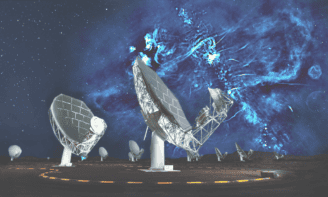Flash Physics is our daily pick of the latest need-to-know developments from the global physics community selected by Physics World‘s team of editors and reporters
Worldwide telescope attempts to image a black hole
An attempt to obtain the first ever image of the Milky Way’s supermassive black hole has begun. The Earth-sized Event Horizon Telescope (EHT) has launched a 10 day run to obtain the portrait via very-long-baseline interferometry (VLBI). The telescope comprises eight radio dishes across the globe, including the Atacama Large Millimeter/submillimeter Array (ALMA) in Chile, the South Pole Telescope (SPT) in Antarctica, and the IRAM 30 metre telescope in Spain. Since its first measurements in 2007, the EHT has yielded tantalizing results even without the full array of telescopes. Now, all eight are linked and looking at our black hole, Sagittarius A* (Sgr A*), as well as the even bigger one in the neighbouring galaxy M87. Although black holes are inherently invisible because of their extreme density and gravitational field, the researchers hope to image the point where matter and energy can no longer escape – the so-called event horizon. “This week heralds an exciting and challenging endeavour for astronomy,” says France Córdova, director of the funding agency National Science Foundation. For more information on the EHT, see our feature “Portrait of a black hole“.
Nanoparticles help molten polymers flow
The addition of tiny particles to a molten polymer can help the material to flow more easily, according to a study led by Erkan Senses and Antonio Faraone of NIST and the University of Maryland in the US. This comes as a surprise because normally the addition of nanoparticles to a polymer results in a reduction of flow. Polymer materials comprise long strand-like components that entangle together to form familiar materials such as plastics. Melting polymers so that they can be moulded and extruded plays an important role in manufacturing. However, the entangled nature makes it difficult for some molten polymers to flow. Senses and Faraone added gold particles just 3 nm in diameter to the polymer polyethylene oxide. Using a number of different analysis techniques, the team showed that the viscosity of the mixture was lower than that of pure polyethylene oxide. The nanoparticles are smaller than the gaps between the entangled strands, and by settling into these gaps, the team believes that the nanoparticles are able to push the strands apart and cause the molten polymer to flow more freely. The team also looked at what happened when 20 nm particles are introduced. These are larger than the gaps between the strands and they had the opposite effect of reducing the viscosity. The research is described in Physical Review Letters.
“Background-free” neutrinoless double-beta decay search comes up cold
GERDA – an array of semiconductor detectors immersed in a bath of liquid argon – has failed to see any evidence for neutrinoless double-beta decay. Neutrinoless double-beta decay is a hypothetical process whereby two neutrons in a nucleus decay to two protons and two electrons – but no neutrinos. Expected to be extremely rare, this decay process is only possible if the neutrino is its own antiparticle – a Majorana particle – which is a feature of some extensions to the Standard Model of particle physics. Measuring neutrinoless double-beta decay would provide important information about the masses of neutrinos – physicists know the particles have mass, but not what the masses of different types of neutrinos are. One of the few nuclei that could possibly undergo neutrinoless double-beta decay is the naturally occurring isotope germanium-76. GERDA takes advantage of the fact that germanium can be used to create very good radiation detectors. Neutrinoless double-beta decay would produce two electrons within a germanium detector, which creates two pulses of positive charge that are collected by an electrode. Because these pulses are created very close together in the detector, they will arrive at the electrode at more or less the same time. This allows GERDA physicists to reject background events involving stray gamma rays scattering twice from different places in a detector. To be extra sure of rejecting such background events, GERDA also looks for flashes of light in the liquid argon, which are produced when gamma rays pass through. The experiment is also surrounded by a tank of water that eliminates background signals from cosmic rays. Now, after running with this configuration since December 2015, the team has announced that the measurement is essentially free of background signals. While the researchers have not seen any evidence for neutrinoless double-beta decay, they can say that the half-life for the process in germanium-76 is greater than about 5 ×1025 years. Because of the background-free nature of GERDA, expanding its size and running it for longer times could help physicists decide whether neutrinos are Majorana particles. The results are described in Nature.
- You can find all our daily Flash Physics posts in the website’s news section, as well as on Twitter and Facebook using #FlashPhysics.



